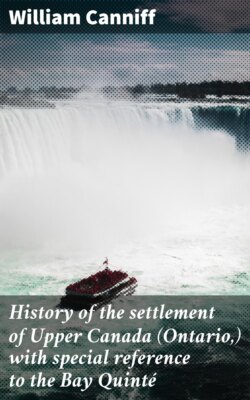Читать книгу History of the settlement of Upper Canada (Ontario,) with special reference to the Bay Quinté - William Canniff - Страница 42
На сайте Литреса книга снята с продажи.
THE MOHAWKS AS CANADIANS.
ОглавлениеDescendants of the bravest of all the brave Indian warriors of America, we find them peaceable and in most respects imbibing the spirit of the day. Ever since the party settled on the bay, they have manifested no turbulent spirit, none of those wild attributes natural to the wild-woods Indian, toward their white neighbors. Among themselves there has been one occasion of disturbance. This arose from the quarrelsome nature of one Captain Isaac Hill. This Chief, with his people, formed a part of Brant’s company that settled on the Grand River. After a few years, having disagreed with his nation, and become exceedingly disagreeable from his officious and selfish conduct, he removed to the bay, and united himself with Captain John’s party, which received him. But he failed to live peaceably with them. Eventually the disagreement resulted in a serious hostile engagement between the two branches, who fought with tomahawks and knives. But one person was killed, a chief of Captain John’s party, Powles Claus, who was stabbed in the abdomen. But subsequently Captain Isaac Hill became a worthy inhabitant. His house still standing, then considered large, was frequently open to the more festive, across the Bay in Sophiasburgh.
Out of the six hundred Indians, now living upon the Reserve, there is only one with pure Indian blood. His name is David Smart. It has been elsewhere stated, that the custom prevailed among the Mohawk nation, to maintain the number of the tribe, by taking captive a sufficient number to fill the vacancies caused by death of their people. The result was, that these captives marrying with Indians, they gradually underwent a change, and the original appearance of the Mohawk has lost its characteristic features. The circumstances of the Indians during the revolutionary war, and subsequently in settling in Canada, led to frequent unions between the white men of different nationalities and the Indian women. Therefore, at the present day there remains but little more than a trace of the primal Indian who lorded it, a hundred years ago, over no inconsiderable portion of the North American Continent.
When visiting the Indians, on our way, we met some eight or ten sleighs laden with them, returning from a funeral. We were much struck with the appearance of solid, farmer-like comfort which their horses and conveyances exhibited, as well as they themselves did in their half Canadian dress.
While drunkenness has prevailed among the older Indians, it is pleasing to know that the younger ones are far more regular in their habits. For this, much credit is due to the Christian oversight of their former and present pastors. They have 1800 acres of land. They number 630, and are increasing yearly.
The seal of the Mohawk Counsel may be seen with the Rev. Mr. Anderson. The armorial bearings consist of the wolf, the bear and the turtle. These animals, in the order here given, indicate, not tribes, nor families exactly, but rank. The wolf is the highest class, the bear next in rank, and the turtle the lowest grade.
